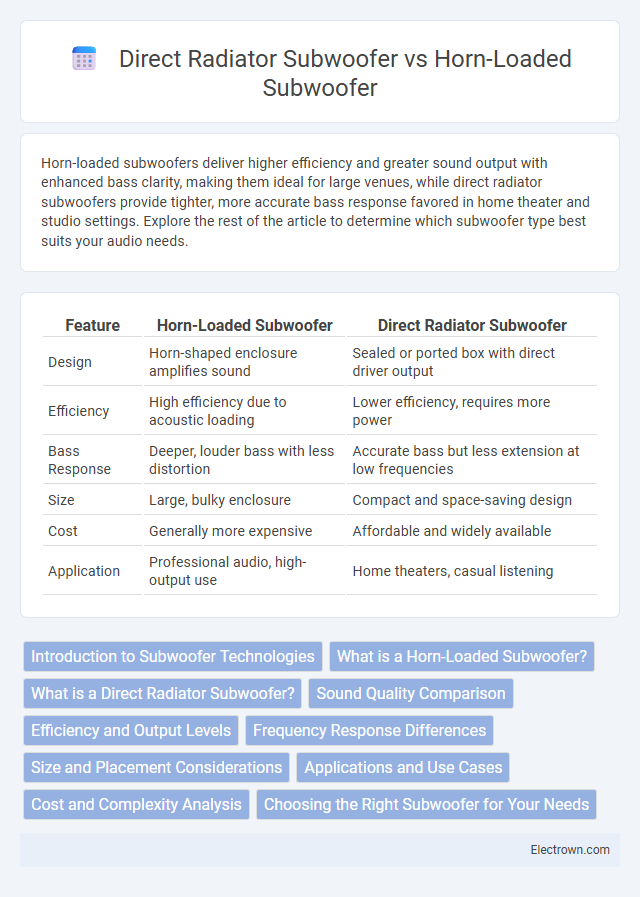Horn-loaded subwoofers deliver higher efficiency and greater sound output with enhanced bass clarity, making them ideal for large venues, while direct radiator subwoofers provide tighter, more accurate bass response favored in home theater and studio settings. Explore the rest of the article to determine which subwoofer type best suits your audio needs.
Table of Comparison
| Feature | Horn-Loaded Subwoofer | Direct Radiator Subwoofer |
|---|---|---|
| Design | Horn-shaped enclosure amplifies sound | Sealed or ported box with direct driver output |
| Efficiency | High efficiency due to acoustic loading | Lower efficiency, requires more power |
| Bass Response | Deeper, louder bass with less distortion | Accurate bass but less extension at low frequencies |
| Size | Large, bulky enclosure | Compact and space-saving design |
| Cost | Generally more expensive | Affordable and widely available |
| Application | Professional audio, high-output use | Home theaters, casual listening |
Introduction to Subwoofer Technologies
Horn-loaded subwoofers utilize a flared horn structure to amplify sound pressure and increase efficiency, delivering impactful low-frequency output with greater acoustic power compared to direct radiator subwoofers. Direct radiator subwoofers rely on a driver that moves air directly without a horn, offering simpler design, more accurate bass response, and often better transient performance. The choice between horn-loaded and direct radiator subwoofers depends on application-specific needs such as output requirements, footprint constraints, and sound quality preferences.
What is a Horn-Loaded Subwoofer?
A horn-loaded subwoofer uses a flared acoustic path to amplify sound waves from the driver, increasing efficiency and bass output compared to direct radiator subwoofers. This design leverages the horn shape to improve sound projection, delivering deeper and more powerful low frequencies with less amplifier power. Horn-loaded subwoofers are favored in large venues and professional audio systems for their ability to produce high sound pressure levels with reduced distortion.
What is a Direct Radiator Subwoofer?
A direct radiator subwoofer uses a driver that moves air directly through a cone, creating sound waves with minimal enclosure manipulation, resulting in clear and accurate bass reproduction. Unlike horn-loaded designs, direct radiator subwoofers rely on the driver's efficient cone surface area and cabinet size to produce deep low frequencies without amplification of specific frequency ranges. This design typically offers faster transient response and a more natural sound, making it ideal for precise bass performance in home and studio audio environments.
Sound Quality Comparison
Horn-loaded subwoofers produce higher efficiency and deeper bass extension due to their acoustic amplification design, delivering more impactful and precise low frequencies with reduced distortion. Direct radiator subwoofers offer tighter transient response and faster driver recovery, resulting in more accurate and natural sound reproduction, though often at lower output levels compared to horns. The choice between the two hinges on desired balance between SPL (sound pressure level) and transient accuracy, where horn-loaded excels in power and reach, while direct radiators prioritize clarity and detail.
Efficiency and Output Levels
Horn-loaded subwoofers achieve higher efficiency and output levels by using a horn-shaped enclosure that amplifies the sound waves produced by the driver, resulting in greater sound pressure levels with less power input. Direct radiator subwoofers rely solely on the driver's movement within a sealed or ported enclosure, producing lower efficiency and output compared to horn-loaded designs. The increased efficiency of horn-loaded subs makes them ideal for large venues and professional audio applications where high volume and clarity are essential.
Frequency Response Differences
Horn-loaded subwoofers provide enhanced low-frequency efficiency and extended bass response by using an acoustic horn to amplify sound waves, resulting in a lower cutoff frequency around 20 Hz with reduced distortion. Direct radiator subwoofers typically exhibit a flatter frequency response but struggle to reproduce very deep bass below 30 Hz without requiring larger drivers or enclosures. The frequency response of horn-loaded systems generally features a pronounced peak near the horn's resonant frequency, while direct radiators deliver smoother, more linear response across mid-to-low bass frequencies.
Size and Placement Considerations
Horn-loaded subwoofers require significantly more space due to their larger enclosure size, making room size and placement key factors in achieving optimal bass response. Direct radiator subwoofers offer greater flexibility with their compact design, allowing for easier integration into smaller rooms or discreet setups. Your choice depends on available space and desired placement options, with horn-loaded designs excelling in open environments and direct radiators fitting well in confined areas.
Applications and Use Cases
Horn-loaded subwoofers excel in large venues and outdoor events where high sound pressure levels and extended bass projection are essential, making them ideal for concerts, festivals, and stadiums. Direct radiator subwoofers are preferred for home theaters, studios, and smaller venues due to their compact size, precise bass response, and ease of placement. Your choice depends on the acoustic environment and required output; horn-loaded designs suit professional sound reinforcement, while direct radiators fit controlled, nearfield listening scenarios.
Cost and Complexity Analysis
Horn-loaded subwoofers typically incur higher costs due to complex enclosure design, larger size, and specialized construction materials aimed at enhancing efficiency and output. Direct radiator subwoofers offer a more straightforward design with fewer components, reducing manufacturing and maintenance expenses while simplifying installation. Choosing between the two depends on budget constraints and willingness to manage complexity for desired sound performance.
Choosing the Right Subwoofer for Your Needs
Horn-loaded subwoofers deliver greater efficiency and higher sound pressure levels, making them ideal for large venues and outdoor events where powerful bass is essential. Direct radiator subwoofers offer cleaner, more accurate bass reproduction and are better suited for home theaters or studios requiring precise sound control. Evaluating factors like room size, listening preferences, and budget helps determine the optimal subwoofer type for your audio needs.
horn-loaded vs direct radiator subwoofer Infographic

 electrown.com
electrown.com